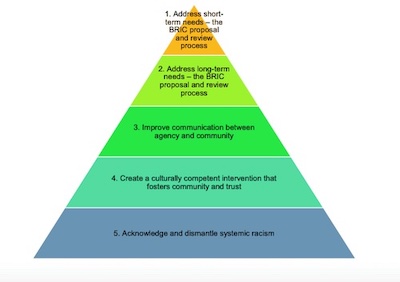By Rebecca Murphy

What are the disaster resilience needs of different types of disadvantaged groups?
This was a key question posed within Dr. Cassandra Davis’s recent report from the Coastal Resilience Center at UNC Chapel Hill, titled “Support Strategies for Socially Marginalized Neighborhoods Likely Impacted by Natural Hazards”. Dr. Davis provided an engaging presentation on the report and its findings to the Natural Hazards Speakers Series class in early February and left students with meaningful ways to consider how future policies could increase resiliency and reduce risk to disadvantaged communities in the face of natural hazards and disasters.
As Dr. Davis described, the purpose of this research was to address equity in emergency management, and in turn, offer a structure for federal agencies, such as FEMA, to enhance their hazard mitigation assistance programs. Principally, her presentation highlighted primary findings as well as certain policy recommendations, such as short and long-term strategies to enhance FEMA’s Building Resilient Infrastructure and Communities (BRIC) program process. Yet, in addition to the core pieces of the report, there were several concepts and themes that also personally emerged for me from Dr. Davis’s presentation and subsequent Q&A.

“Support Strategies for Socially Marginalized Neighborhoods Likely Impacted by Natural Hazards” (Davis et al., 2021).
(1) The terms that we used around natural hazards and marginalized populations matter.
One of the first points that Dr. Davis made in her presentation, and included in the report, was the need to more closely examine how we define “vulnerability” and why this term can be both misleading and damaging when describing disadvantaged groups in the natural hazards space. Specifically, she explained that defining a group or community as socially vulnerable may not only fail to consider certain historical and/or social factors that exacerbate hazard impacts, but it also “suggests a static state and denotes weakness.” Instead, Dr. Davis pointed to the terms “socially marginalized” and “underrepresented” as better identifiers of those that have been disadvantaged by the current social, political, and economic structures that are institutionalized in today’s society.
Having just recently learned the particular vocabulary surrounding natural hazards, adaptation, and mitigation during my graduate coursework over the past year, hearing Dr. Davis make this important distinction within her research and discussion allowed me to think more critically about how we tend to discuss and perceive those disproportionately impacted by natural hazards. As a note, her report also includes a comprehensive summary of how certain individuals and groups tend to be more disadvantaged by natural hazards, which I found to be helpful in order to further understand why the term “vulnerability” is unsuitable as a term within fundamental equity contexts.
(2) There is no direct path to foster community trust and collaboration around mitigation.
During the Q&A portion of her presentation, Dr. Davis shared her own personal experiences in engaging with marginalized communities around mitigation and discussed types of partnerships and social networks that she views as most effective at fostering collaboration and support for marginalized groups. In particular, she pointed to the necessity of both leveraging local knowledge and perspectives through participatory action research and action (PAR) as well as working alongside community-level organizations to better establish trust and communication with residents.
Although these lessons may be applicable to many non-hazard related community engagement objectives, Dr. Davis illustrated how they are especially pertinent around hazard resilience in order to ensure that mitigation support and resources are equitably distributed across members of the community. As such, her discussion made me more thoughtfully consider how different values and perspectives could be incorporated into future hazard mitigation plans and what these actions might potentially look like within my own community.

Figure 2: “Repairing Community Through Structural Change” (Davis et al., 2021). The pyramid highlights policy changes that are necessary within the BRIC program in order to support socially marginalized communities.
(3) Systemic change can start through short-term action.
Towards the end of her presentation, Dr. Davis reflected on several key policy recommendations that the report provides in order to advance the BRIC program’s resources for underrepresented communities. She illustrated these recommendations in a pyramid ranging from goals to “address short-term needs in the BRIC proposal and review process” at the top to “acknowledge and dismantle systemic racism” at the pyramid bottom. Dr. Davis acknowledged that certain recommendations may not be tangible within the next decade or longer, but are key to addressing structural change within the current mitigation system.
Looking at the scale of steps to bring such change can certainly appear overwhelming. However, Dr. Davis described this path with encouragement and optimism, as well as concrete steps to initiate short-term improvements in the BRIC system. From her report and discussion, I look forward to seeing if and how BRIC personnel incorporate these recommendations to increase equity in future years. Personally, I am already encouraged by FEMA taking the promising step to track the race of disaster-aid applicants and analyze if discrimination is occurring in its funding structure.